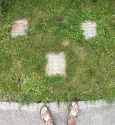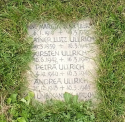On a bicycling vacation one does not expect to confront the horrors of World War II. Maria has been blogging elsewhere about our trip to Europe with our Cruzbike Q45s. This post is about a moving experience not directly related to Cruzbike.
Bicycling all day through Bavaria and strolling the ancient streets of Rothenburg ob der Tauber had been fabulous, but quickly depleted our stock of clean clothes, thus requiring a trip to Würzburg, the closest city with a laundromat.

After starting the drying cycle, Maria and I walked down the city street with exactly 32 minutes to kill. We passed many young people on the streets coming home from work to the tall apartment buildings all around us. We came upon an old stone wall with an open door and stepped into a small green field in the corner of the city cemetery, with flat markers overgrown with grass and weeds. Many names were etched on each stone, with a wide variety of birth dates, but all ominously had the same death date: March 16, 1945. There was no one else on the field with us, and no historical markers to explain what we were seeing.

With phone-in-hand, I googled “Würzburg bombing” and immediately saw the date was the same as on the stones under my feet. I learned that on that date RAF bombers flew from England and dropped approximately 1200 tons of bombs and incendiary devices over Würzburg, killing 5000 people and destroying most of the city. Suddenly I realized I was standing over the remains of the 3000 victims whose remains could be identified. Because the bombing created a firestorm with temperatures of 1500-2000 degrees C, many remains could not be found (for reference, both glass and steel melt between 1300-1400 degrees C).
I have been a student of World War II, having watched countless documentaries and dramas portraying the major battles and, of course, the Holocaust. I have not spent much time pondering the suffering of innocent Germans, who are seldom the subject of those documentaries and dramas. The story told in the grave marker (photo above) brought home the bombing of Würzburg with a vision of the Ullrich sisters, Petra, Kirsten, and Andrea, clutching their mother as the firestorm swept through the town. Their older brother, Rainer, turned six-years-old the day he perished with his mother and sisters. Had they had a party for him? Was that why they had not made it into a bomb shelter in time?
Their mother, looks like her name was Anne, was 29. On adjacent stones were other family names: Stern, Schlitter, Schmitt, and Steinrichter. This small German town lost 5000 lives in a 20-minute bombing raid. That’s more deaths than the Allied forces suffered during the D-day invasion of Normandy, and I would venture to guess that most Americans have never heard of Würzburg, or its bombing. I found this Wikipedia article fascinating in its explanation of why and how the city was selected, and how its destruction was accomplished. The bombing was judged to be proportionally more successful than even the famous bombing of Dresden in terms of the percentage of death and destruction.
Our tour continues through the peaceful villages of Germany, but I cannot forget either the suffering the Germans caused, nor the suffering they endured during the nightmare period when Hitler’s National Socialist party had control of an otherwise great nation.

Bicycling all day through Bavaria and strolling the ancient streets of Rothenburg ob der Tauber had been fabulous, but quickly depleted our stock of clean clothes, thus requiring a trip to Würzburg, the closest city with a laundromat.

After starting the drying cycle, Maria and I walked down the city street with exactly 32 minutes to kill. We passed many young people on the streets coming home from work to the tall apartment buildings all around us. We came upon an old stone wall with an open door and stepped into a small green field in the corner of the city cemetery, with flat markers overgrown with grass and weeds. Many names were etched on each stone, with a wide variety of birth dates, but all ominously had the same death date: March 16, 1945. There was no one else on the field with us, and no historical markers to explain what we were seeing.

With phone-in-hand, I googled “Würzburg bombing” and immediately saw the date was the same as on the stones under my feet. I learned that on that date RAF bombers flew from England and dropped approximately 1200 tons of bombs and incendiary devices over Würzburg, killing 5000 people and destroying most of the city. Suddenly I realized I was standing over the remains of the 3000 victims whose remains could be identified. Because the bombing created a firestorm with temperatures of 1500-2000 degrees C, many remains could not be found (for reference, both glass and steel melt between 1300-1400 degrees C).
I have been a student of World War II, having watched countless documentaries and dramas portraying the major battles and, of course, the Holocaust. I have not spent much time pondering the suffering of innocent Germans, who are seldom the subject of those documentaries and dramas. The story told in the grave marker (photo above) brought home the bombing of Würzburg with a vision of the Ullrich sisters, Petra, Kirsten, and Andrea, clutching their mother as the firestorm swept through the town. Their older brother, Rainer, turned six-years-old the day he perished with his mother and sisters. Had they had a party for him? Was that why they had not made it into a bomb shelter in time?
Their mother, looks like her name was Anne, was 29. On adjacent stones were other family names: Stern, Schlitter, Schmitt, and Steinrichter. This small German town lost 5000 lives in a 20-minute bombing raid. That’s more deaths than the Allied forces suffered during the D-day invasion of Normandy, and I would venture to guess that most Americans have never heard of Würzburg, or its bombing. I found this Wikipedia article fascinating in its explanation of why and how the city was selected, and how its destruction was accomplished. The bombing was judged to be proportionally more successful than even the famous bombing of Dresden in terms of the percentage of death and destruction.
Our tour continues through the peaceful villages of Germany, but I cannot forget either the suffering the Germans caused, nor the suffering they endured during the nightmare period when Hitler’s National Socialist party had control of an otherwise great nation.

Last edited:



